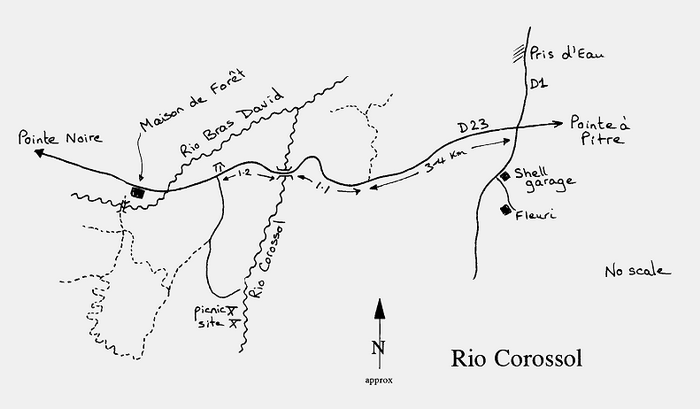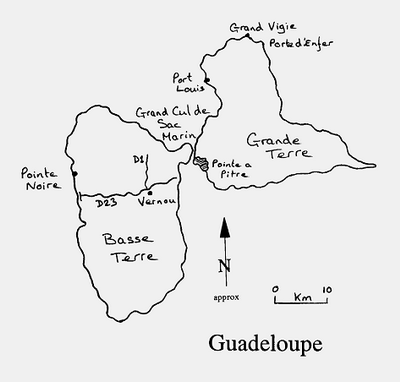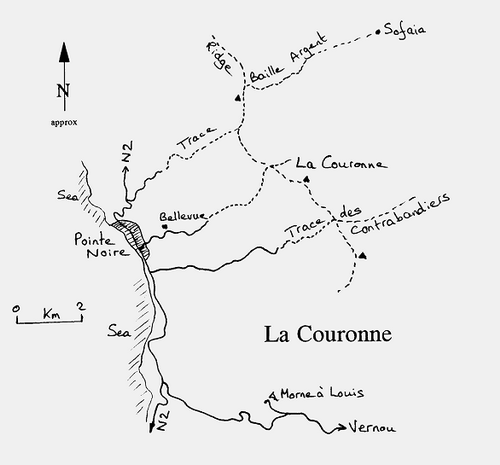Section 1 - Introduction, logistics, itinerary and general information.
Section 2 - Birding sites (Martinique).
Section 3 - Birding sites (Guadeloupe).
Section 4 - Birding sites (Dominica).
Section 5 - Birding sites (St. Lucia).
Section 6 - Annotated checklist.
Guadeloupe
Guadeloupe's only endemic bird is the Guadeloupe Woodpecker, which is common in several well forested areas of the island. Of other, more restricted Lesser Antillean species occurring here;
|
Forest Thrush, Brown Trembler, Pale-eyed Thrasher and Plumbeous Warbler, only the, somewhat elusive, Forest Thrush might be more difficult to find elsewhere, and as such is worth investing some effort to find. Guadeloupe is comprised of two islands - Grande-Terre and Basse-Terre. From a birding point of view Basse-Terre is far more interesting as it still holds relatively extensive areas of forest. Guadeloupe 1. Vernou The small village of Vernou makes a good base from which to work the forests of central Basse-Terre. We stayed at, and would recommend, the Le Monte Fleuri guesthouse, which at 250 Fr/double inc. breakfast was a good deal, especially as the location was quiet, and had hot water and a/c. You can even prepare your own meals if you wish. The guesthouse is located just off the main N1 road, behind the Shell petrol station (see map below). |
Birders have worked several forested areas in the vicinity, and anywhere with good forest is likely to be productive. Try the picnic site at the Rio Corossol, the trails of the Maison de Forêt and the Pris d'Eau area.
Rio Corossol: From Vernou, return to the D23/D1 intersection, and head westward on the D23, cross-island road. After about 3-4 kilometres you cross the well-marked Rio Corossol. After a further 1.2 kilometres take the left turn and follow the pot-holed road about 2 kilometres to its end, to arrive at the Rio Corossol picnic site. This area should be avoided at weekends, although early morning there is unlikely to be anyone around. About half way along this access road you will see a well defined footpath leading off, uphill on the right - this leads straight into good forest and connects with the forest trails of the Maison de Forêt. The best birding is around the river and picnic site early morning, where you may be lucky enough to find Forest Thrush feeding around the picnic tables. Brown Trembler is common, and the Guadeloupe Woodpecker and Plumbeous Warbler might be found if walking the road.

Additionally we worked an area on the opposite side of the main D23 road. To find this track, return to the main road, drive back toward Vernou, and cross the Rio Corossol again. At 1.1 km from the river, a wide track leads off left, north. Although this track was not particularly productive it was good for Guadeloupe Woodpecker, and was the only place we saw Lesser Antillean Flycatcher on Guadeloupe.
Maison de Forest: Starting from Vernou, proceed westward, as before, crossing the Rio Corossol. Between 2 and 3 kilometres (didn't measure it exactly) after the river, you will see the Maison de Forêt visitor centre on the left. This is the starting point for several excellent forest trails, which begin after crossing the river on a large footbridge. The centre doesn't open until 09:30, and there is no visitors board with a trail map (maybe one can obtain a map when the centre opens?). However, the trails are well marked, so getting lost is not a concern. Both quail-dove species occur, and Forest Thrush should be looked for in forest near the river.
Pris de l'Eau: These details are provided by John Wall who birded this area in 1990. From the intersection of the D23/D1 travel northward along the D1 toward Pris de l'Eau. After about 1-2 kilometres, turn left at the large "INA" sign pointing toward the Station de Reserches de Zoologie. Follow this road for about 3 kilometres, past the school to where suitable forest starts. Park and walk. Guadeloupe Woodpecker is common, as are the other specialities, with the possible exception of Forest Thrush.
Species recorded at Vernou and Maison des Forêt:
American Kestrel 2 |
Lesser Antillean Pewee 2 |
Guadeloupe 2. La Couronne
La Couronne is one of a chain of mountain peaks in northern Basse-Terre. Several hiking trails, starting from the western coast, can be found over this massif - we just chose one at random. If leaving from Vernou, cross Basse-Terre on the D23 to arrive at the west coast, turn northward along the coastal highway and use a good map to explore any likely looking track leading into the hills.
The Couronne track, passing through the tiny village of Bellevue, is sign-posted off the main road just after entering the southern edge of Pointe Noire. Follow the steep, but driveable, track for about 3 kilometres, and then walk. From here the track ascends more slowly, passing through a succession of habitats; initially cultivation and scrub, then dry forest, and finally rainforest where the track turns into a forest trail. As we only worked the dry forest areas the species list is rather short. Calls of a Quail-Dove sp. heard from the dry forest appeared to be intermediate between Ruddy and Bridled. However, dense habitat prevented us resolving the issue. As we subsequently discovered, habitat in the Lesser Antilles, is not a good indicator as to which species occurs (see systematic list below). Other cross-island trails in this area, which presumably hold interesting species, include the Trace des Contranbandiers and the Trace Baille Argent to Sofaia. |
|
Species recorded at Couronne:
Zenaida Dove 4+ |
Black-whiskered Vireo 4 |
Guadeloupe 3. Other possibilities
The D23 highway, crossing Basse Terre, through the protected central forests, offers several opportunities to stop and explore. The high ground at Morne à Louis around the microwave tower should be interesting, and has breeding American Black Swift.
On Grand Terre, we visited the mangroves just to the north of Port Louis. These are good for herons, waders and migrants. They can be accessed along several rough tracks leading north from the cemetery by the beach at the northern end of town. The cemetery is easily found as it is adjacent to a large beach-picnic area, and is signposted in the town.
The rocky headlands of the northern coast between Pointe de la Grande Virgie and Pointe des Gros Caps have impressive scenery, and small numbers of breeding Red-billed Tropicbird nearby. A good cliff walk starts at Lagon de la Porte d'Enfer and runs southward.
Numerous small islets in the Grand Cul de Sac Marin, between Basse Terre and Grand Terre, are very good for breeding seabirds.
Section 1 - Introduction, logistics, itinerary and general information.
Section 2 - Birding sites (Martinique).
Section 3 - Birding sites (Guadeloupe).
Section 4 - Birding sites (Dominica).
Section 5 - Birding sites (St. Lucia).
Section 6 - Annotated checklist.


